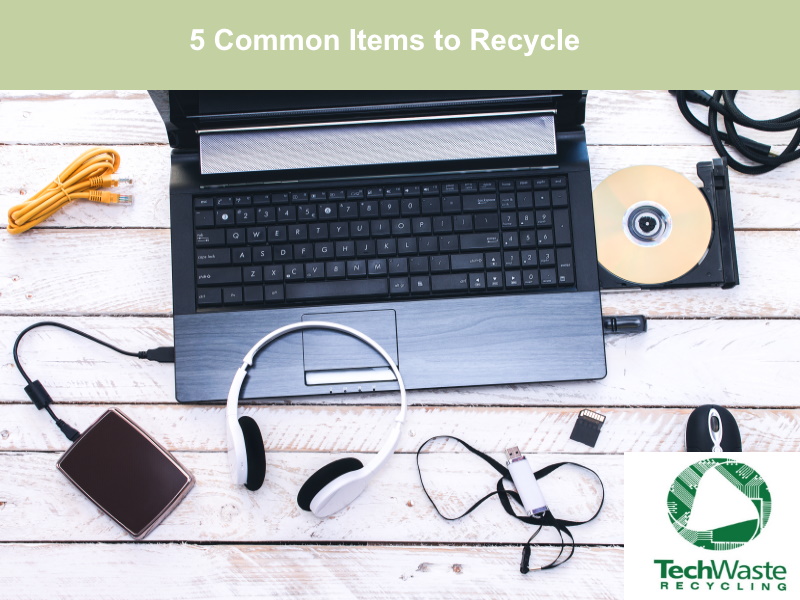There are many common items that can and should be recycled. Paper and plastic come to mind. Additionally, milk cartons, drink cans, and grass clippings are compostable. However, let’s consider 5 everyday items that may be more challenging to recycle. These 5 products are required to be recycled. Let’s investigate the what and why behind each.

The 5 Common Items that Should be Recycled
1. Computer Peripherals
We use computer peripherals such as mice and keyboards daily in our homes and offices. Companies and corporations typically have dozens of each on-site. Hard drives external, Ethernet cables, and charging cables are additional computer equipment that should be recycled.
Why recycle?
Keyboards, mice, and similar products have recyclable components, such as wiring. This material can be recycled into new products. In addition, they include circuit boards that must be recycled for 2 reasons. First, these items can be shredded and separated, and the metals they contain are recyclable like similar accessories. Second, these circuit boards may contain dangerous chemicals and materials that require proper disposal instead of being dumped in landfills.
2. All Types of Light Bulbs
These include LED, fluorescent, compact fluorescent, and incandescent, which should be recycled. You may have used old fluorescent tube bulbs in your garage or basement. LED lights are prevalent in new light fixtures (such as ceiling fans with integrated lighting) and strip lights under counters and cupboards. There are still stores that sell and use incandescent light bulbs for ceiling fixtures and lamps. CFL bulbs are replacing incandescent bulbs because of their longer lifespan and lower energy usage.
Why recycle?
Mercury powder is present in compact fluorescent light bulbs and fluorescent tube lamps. Mercury powder is dangerous to the environment and can contaminate the soil and water. Animals and humans who ingest contaminated water can get sick. Moreover, contaminated soil makes land unsuitable for plant growth. LED lights have circuit boards in the base. The bases and wires of incandescent light bulbs are recyclable and reusable. These circuit boards must be shredded and sifted to remove any hazardous components before reuse.
3. Cellphones
People of all ages use smartphones and flip phones for a variety of purposes. Phones are now utilized for more than just making calls. We now use them to text, check email, obtain directions, and do online research. They serve as our calendars, calculators, and cameras.
Why recycle?
Flip phones and smartphones both include circuit boards and rely on batteries to operate. Circuit boards should be recycled in order to reuse the metal and keep dangerous elements contained, as well as for their plastic and wire. Cell Phone batteries need to be handled carefully throughout the entire process, from collection to destruction, to ensure their safety.
4. AA Batteries and AAA Batteries
AA and AAA batteries include an assortment of metals and chemicals. Lithium, alkaline, and other types of batteries appear indistinguishable to the untrained eye. However, they require separate techniques for sorting, storing, packaging, and transportation. Over time, if batteries are abandoned in a landfill, the outer protective coating can erode, allowing the chemicals within to escape. These contaminants are absorbed by precipitation and runoff and can contaminate the soil and water surrounding the landfill. In addition, batteries in landfills can rapidly ignite difficult-to-contain fires that release toxins into the atmosphere.
Why recycle?
A variety of metals and chemicals can be used to produce AA and AAA batteries. To the untrained eye, alkaline, lithium, and other varieties are all similar. However, they need various techniques for sorting, storing, packing, shipping, and recycling. The protective coating on the outside of the batteries may deteriorate over time and the chemicals inside may spill if these are thrown in a landfill. These substances can contaminate the soil and water around the landfill when they are carried away by rain and runoff. Batteries in landfills can also readily ignite fires that are challenging to put out and spew poisons into the air.
Items that Qualify to be thrown away as E-waste
5. Television
Every home in the world has a television. There are several in many homes. Depending on their location and intended usage, they are available in a range of sizes. Over time, televisions have become lighter and of higher quality. They are also now more reasonably priced. They are regularly replaced as a result.
Why recycle?
Every type of television has specific recycling specifications (LCD, Plasma, CRT). Lead is present in CRT televisions, which must be handled carefully in accordance with national and international standards. Metals found inside CRT televisions can also be recycled and used again. The screens of LCD and plasma TVs must be taken off and recycled correctly. They also include circuit boards, which are recyclable after being destroyed. Hazardous items must be segregated from non-hazardous materials.
The 5 items listed above are the objects to recycle each day. Remember that the object in your hand, the item you scarcely even think about, can and should be recycled the next time you consider replacing your cell phone or unscrewing a burnt-out lightbulb to replace it with a more energy-efficient version. Not only does it contain components that can be recycled, but it also might contain dangerous or hazardous materials that, if not handled properly, can affect our soil, water, and air.
Electronic recycling R2-certified companies like TechWaste Recycling can also manage the disposal of these 5 items. Give them a call to schedule a pickup; see locations here.

































